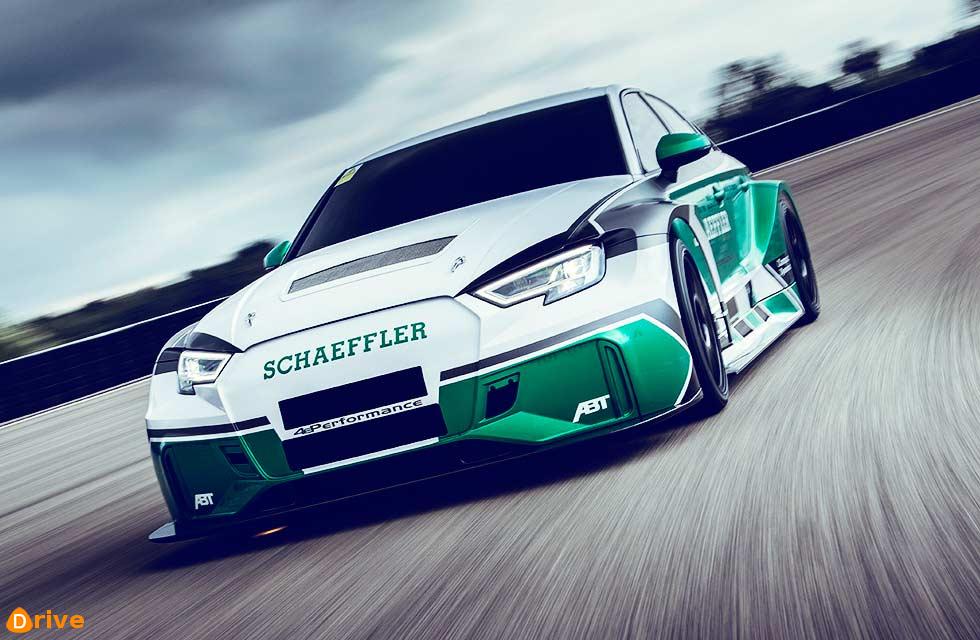Schaeffler turns RS3 TCR touring car racer into a four-motor, all-wheel drive electric dynamo.
Automotive components giant Schaeffler has fitted an Audi RS3 with a unique 1200bhp, four-motor electric powertrain that can perform doughnuts from stationary with no steering angle to showcase the performance potential of EV technology.

The 4ePerformance demo car is based on an RS3 TCR touring car racer, but has a powertrain system that uses technology taken from Audi’s Formula E racer. Schaeffler is a technical partner of the German firm’s team in the electric single-seater series.
The 4ePerformance is fitted with four motors and inverters, each driving one wheel. A 64kWh battery contributes to a total weight of 1800kg – around 600kg more than the RS3 TCR car – but with so much power and torque, the car can do 62mph in 2.5sec and 124mph just four seconds later.
An all-wheel torque vectoring system means the car is also capable of spinning 360deg from standstill, with no steering angle. While that function has limited use, Schaeffler electronics engineer Gregor Gruber says it shows how electrification can change the driving experience.
“This car exists first to be a test bed and a demonstrator for our all-wheel torque vectoring capabilities,” he said. “There is clearly no practical application for making a car spin on the spot, but when you realise that all-wheel torque vectoring is so powerful it can make a car do exactly that, you begin to understand how much it can change the behaviour of the car in normal driving. “The second reason this car exists is to showcase technology transfer from Formula E to something that’s more like a road car. The four motors and inverters are lifted from our Formula E car.”
With 92,000 employees around the globe, Schaeffler generated £12.4 billion in sales last year. It supplies powertrain, transmission and chassis technology to OEMs, and like many automotive suppliers has turned its attention to electric and hybrid drivetrains in recent years. Its new £53 million E-Mobility centre in Buhl, Germany, will soon house 500 engineers and researchers.
As well as looking at ‘last-mile’ urban mobility devices, such as electrified scooters and autonomous pods, Schaeffler’s E-Mobility division is also developing innovative hybrid powertrains (see below). From the passenger seat of the 4ePerformance, all-wheel torque vectoring feels like a game-changer for vehicle dynamics. Although huge stacks of batteries generally make such cars much heavier than those with internal combustion engines, they are far more agile and responsive.
What’s more, the 4ePerformance accelerates so violently and in such an unrelenting way that you have to resist pleading with the driver to make it stop. As head of E-Mobility Jochen Schröder put it: “Electric drivetrains don’t only have to be about reducing carbon emissions.”
EV showcases a powerful all-wheel torque vectoring system. 4ePerformance demo shows transformative potential of EV tech.
SCHAEFFLER BETS ON A HYBRID FUTURE
Schaeffler believes hybrid powertrains will make up a significant proportion of the new car market for the foreseeable future, and is focusing on new technologies accordingly. The firm has labelled its vision for the future of powertrains ‘30:40:30’, predicting that, by 2030, 30% of new cars will be driven by internal combustion engines only, 40% will be hybrid and 30% will be battery-electric.
Jochen Schröder (pictured), Schaeffler’s head of E-Mobility, said that hybrids will grow in popularity in part due to European emissions legislation. By 2025, fleet average CO2 emissions targets for large-scale OEMs could be set as low as 81g/km. The fines for failing to meet such targets have been structured to be greater than the cost of implementing hybrid and EV technologies. With doubts that new car buyers will feel ready for pure electric cars by 2030, hybrids could plug the gap.
Schaeffler recently launched a range of electric drive systems, for use on EVs and hybrids, that are characterised by high power density, compact dimensions and light weight. The new Audi E-tron features Schaeffler’s parallel axis hybrid system on the front axle and its coaxial system on the rear. The latter weighs only 16kg yet can deliver 295lb ft to the wheels.
“We are still optimising the combustion engine,” said Schröder. “It isn’t dead just yet. We take a holistic, well-to-wheel view of carbon dioxide emissions. We have to look at the entire chain rather than focus on tailpipe emissions.”
Schaeffler is also developing autonomous driving technologies and predicts that, by 2035, 9% of new cars will feature level-five, ‘hands off’ autonomy.





